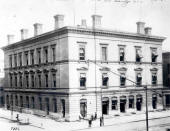Before moving to the building at 46 East Ohio Street in 1905, the Post Office and Court House were located at 45 North Pennsylvania at the southeast corner of Market Street; Frederich Folz’s wagon shop previously stood on this site. A.B. Young, A.B. Mullett, and Francis Costigan prepared and oversaw the design and construction of this Italian Renaissance style building. The original old building, popularly known then as the Post Office Building, was three stories tall and seventy feet wide by ninety feet long, and was completed in 1860 at a cost of $166,240. In August 1873 additional land was purchased to prepare for an addition to double the building’s size and capacity; this work was completed in 1874; the building in its final state measured 202 feet by 198 feet. The Post Office occupied the ground floor and basement, while the second and third stories had offices for the U.S. assessor, collector, district attorney, marshal, clerk, judge, and courtroom could be found. The building had solid limestone walls, every room had a fireplace, and legend has it that the ghost of a man sentenced to death in the court haunted the fourth floor. The Court House was also the site one of the most famous treason trials of the Civil War, a case that ended up in the Supreme Court as Ex parte Milligan, in which the justices ruled that no civilian could be tried by a military court when a civilian court was available.
By 1900 the community was coming to view the building as an eyesore, which is one of the reasons that citizens of Indianapolis were so excited when the current building was built. After the Post Office and Court moved out of the old building, the American National Bank moved in and began major refurbishment projects. Marble was imported from Italy to change the iron posts into more attractive pillars; vaults were moved in; and the layout of the building was altered to suit the bank’s needs. The building remained active as a bank until 1961, when the American Fletcher National Bank merged with Fidelity Bank and Trust and vacated the premises. Despite efforts by preservationists and historians to save the old building, in 1962 the land and building were purchased by Union Federal, which then tore the building down the next year and erected the Union Federal Building.
Indiana Historical Society Bass Photo Collection

